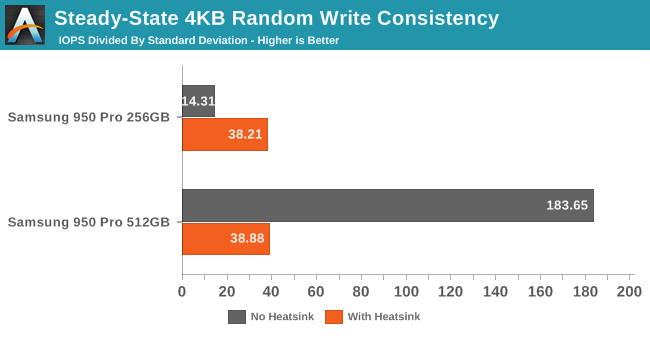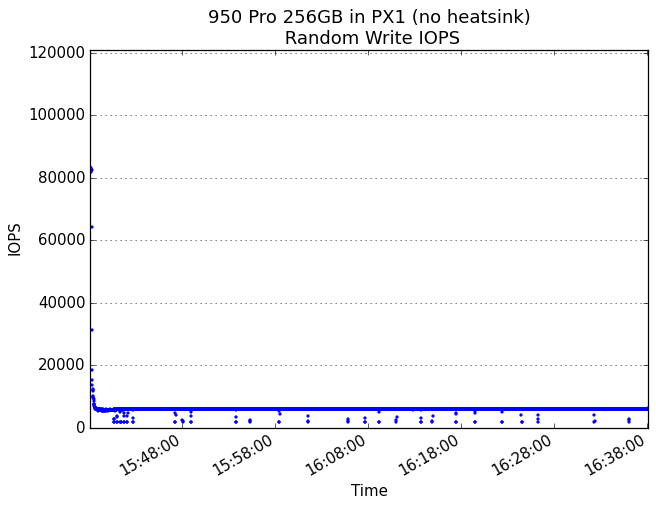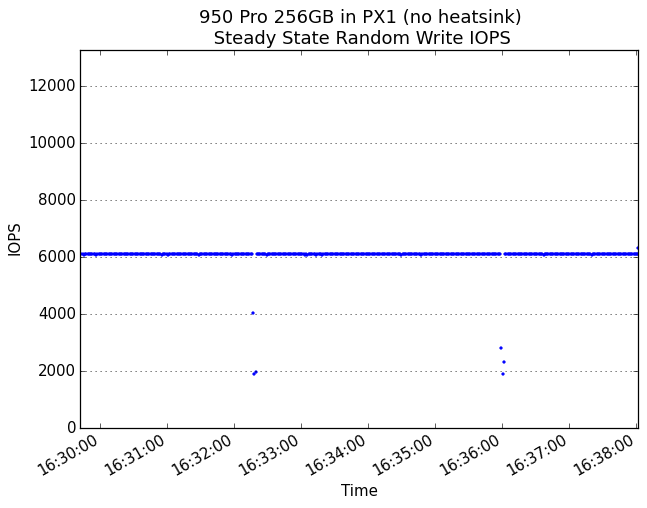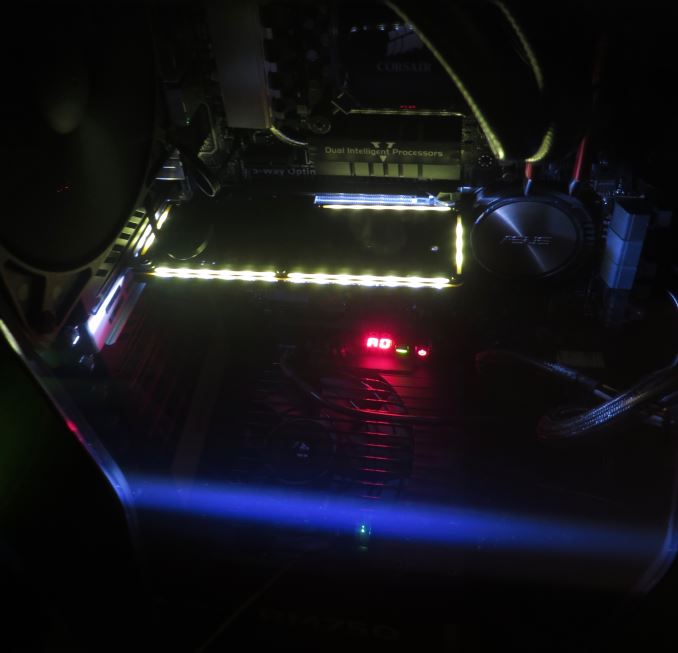The Angelbird Wings PX1 M.2 Adapter Review: Do M.2 SSDs Need Heatsinks?
by Billy Tallis on December 21, 2015 8:00 AM ESTPerformance Consistency
The hour-long random write test we use to analyze performance consistency is where we expect the most severe thermal throttling. After filling the drive, it is subjected to an hour of 4kB random writes at queue depth 32. As the drive's spare area is exhausted, performance drops and then settles down to a steady-state where the controller has to do constant garbage collection to keep up with the constant writes. We score drives on their performance and consistency averaged over the last 400 seconds of the test.
Due to its long duration and high overhead of background work for the controller, this test is where we typically look first for signs of thermal throttling or other problems with the controller. Sudden dramatic drops in performance during this test can indicate that the drive had to switch to a lower-power lower-performance state, or that the drive wasn't keeping pace with all the necessary background processing.


Adding the heatsink shows that the 256GB 950 Pro only had a little bit of room for improvement in steady-state random writes, but the 512GB drive was shackled by its thermal limits. The consistency scores end up very similar for the two drives with the heatsink attached despite the performance difference, which says that the background processing on the 512GB model can scale to keep up with the higher load without hitting any more thermal limits. The extremely high consistency score of the 512GB drive without the heatsink indicates that the drive spent the entire steady-state period in a single power state and wasn't jumping around trying to aggressively eke out a little more performance.
 |
|||||||||
| 256GB no heatsink | 512GB no heatsink | ||||||||
| 256GB with heatsink | 512GB with heatsink | ||||||||
Without the heatsink, both drives perform extremely consistently save for the 256GB's occasional stutter and the blips in performance that both drives experience before reaching steady state.
 |
|||||||||
| 256GB no heatsink | 512GB no heatsink | ||||||||
| 256GB with heatsink | 512GB with heatsink | ||||||||
With the thermal constraints removed, the random write speed starts to vary a little bit, but the low performance outliers are eliminated and the new low is better than the previous high, especially for the 512GB 950 Pro.
Final Words
Our tests of the Samsung 950 Pro in the Angelbird Wings PX1 showed two very different kinds of results. On most of our synthetic Iometer benchmarks of sustained performance, the heatsink enabled huge performance increases. Sequential performance in particular was up to twice as fast—an improvement that we'd be impressed to see from an entirely new product generation, but all we added was a heatsink to a product that traditionally doesn't need such a thing. However, for the random read performance, mixed reads and writes and our AnandTech Storage Bench tests replicating real-world bursts of I/O, the heatsink made no significant differences.
When introducing the 950 Pro, Samsung assurred us that it could manage its heat output. They were right: the 950 Pro achieves a delicate balance where it will almost never overheat from a typical consumer workload, but almost any stress test can trigger sometimes severe thermal throttling. That isn't to say that the heatsink will never help in the real world; those situations are just rare, and even with the thermal throttling it would only take a few minutes to read or write the entire drive. For example, with a heatsink the 512GB 950 Pro is capable of saving an uncompressed 4k 60Hz video stream in realtime, but it'll fill up in six minutes. Other bulk data manipulation like file system or virtual machine snapshotting could be sped up some with a heatsink (provided the task consists of more than just random reads), but in general for consumer hardware and workloads the only source or destination for data that can keep up with the 950 Pro is RAM or another SSD.
If the Wings PX1 were under consideration for use with a low-end PCIe M.2 SSD (more of a hypothetical product category at the moment), I'd say that it's clearly not worth the money over a basic adapter ($25-$30). But the kinds of enthusiasts that would go for the 512GB 950 Pro will want the most out of their purchase and if they need an adapter they may want something nicer looking than a raw socket on a green PCB. The Wings PX1 delivers good looks and the guarantee that your SSD will never experience severe thermal throttling, but going by the MSRP of $75 it also adds 20% to the price of the drive. That puts the combination of the Wings PX1 and the Samsung 950 Pro quite close to the price of a 400GB Intel SSD 750, which already comes with an effective heatsink. However, for everything other than random write performance the 950 Pro is still the clear winner for a client drive.
The dramatic sustained performance improvements enabled by the Wings PX1's heatsink also highlight how modern power efficiency and thermal management design tradeoffs have caught up to the M.2 form factor. With M.2 being designed first and foremost for laptops, it's not very surprising to see that many of the same performance tradeoffs that we already see with laptop CPUs and GPUs have come into play for SSDs as well. In the mobile space we essentially take it as a given that these devices have sustained performance that's going to be lower than their peak performance, a consequence of balancing between performance needs and device size & noise. As current reasoning goes, most client workloads are very bursty and only need peak performance for a short period of time; and while we can certainly dig up counterpoints to this when it comes to CPUs and GPUs, this is admittedly harder with SSDs, especially when the time to completely fill a drive is only a couple of minutes longer than the time it takes to heat up a drive to begin with. In other words, right now PCIe SSDs are a great example of client burst workload optimization in action.
On the other hand in the enterprise space, it is now quite clear that an M.2 drive subjected to a sustained enterprise-like workload needs more than passive bare cooling, which cuts into its size advantage. These are still low-power devices pulling less than a dozen watts, so even some simple forced airflow is likely adequate, but something is required, and that something will take up space.
As for the the Samsung 950 Pro, it attains great performance on client workloads, but without extra cooling its performance on the heaviest of workloads is being held back. If the 950 Pro's successor is to offer increased real-world performance, it will have to also be significantly more efficient in order to keep thermal throttling out of consumer usage scenarios. In the meantime we are probably approaching a plateau for the sustained performance that a bare M.2 drive can offer.











69 Comments
View All Comments
RealBeast - Monday, December 28, 2015 - link
"You know, since the LED's are white" Not really.Tell the Nobel committee about it. The 2014 prize in physics went to the blue boys -- red and green had been around for a while, and only they made white possible: http://www.nobelprize.org/nobel_prizes/physics/lau...
h4rm0ny - Tuesday, December 22, 2015 - link
Whilst agreeing with your point, you want either 'irrespective' or 'regardless', not "irregardless".More on topic I agree with both of you - I both recognize that what Teizo says about the customer base is probably true, and also agree with mooninite's despair that this is so. The two posts are not incompatible.
Murloc - Tuesday, December 22, 2015 - link
-less = withoutir- = in- before an 'r', the same as English un- (in- is latin, un- is germanic), it has a negative or privative force.
pick one but not both.
That said, RGB LEDs would make it cost too much, the price is already too high for consumers.
ddriver - Monday, December 21, 2015 - link
DO'H, it is not rocket science, if it overheads and throttles back as a result, then it obviously needs a heat sink.bug77 - Monday, December 21, 2015 - link
I think these tests answer another important question: when does it overheat.As it is, the drives only overheat during sustained write. This is far from unexpected, but at the same time it is reassuring to know it is the only scenario where a drive would throttle (as opposed to throttling under regular desktop usage).
ddriver - Monday, December 21, 2015 - link
But what about another important question, how much does it "hurt" to add a dollar worth of aluminum to improve a product worth several hundred dollars?bug77 - Monday, December 21, 2015 - link
If you have ever installed an M.2 drive, then you know there's not much space left for a heatsink. And you can only install it on one side. Even so, it's so close to the motherboard (and usually between PCIe slots) that if you don't have a hell of an airflow, it won't make much difference anyway.And that's only for desktops, good luck trying to fit a M.2 drive with a heatsink attached into an ultrabook.
ddriver - Monday, December 21, 2015 - link
You are very limited conceptually - it doesn't have to be a "radiator" type of heatsink, a flat piece of aluminum 2-3 mm thick would suffice. Heatsinks come in various shapes and sizes, not necessary the bulky, thick finned design.The SSD doesn't displace a lot of heat to begin with, but without a heatsink for that HEAT to SINK into the bare chip quickly runs out of thermal room.
Even if it still throttles, it will ramp the temp up slower as the heatsink will act as a buffer, and regardless of how little airflow it may have, a larger piece of aluminum will always displace much more heat than a tiny chip.
It will be slower to overheat and faster to cool, even in an ultrabook or tablet, and yes, with the kind of heatsink it merits it will have no trouble fitting into portable devices.
Judging by the performance regressions from adding a heatsink to the larger model, it would seem that engineers were well aware it throttles and have optimized the product for it, so taking care of the heat puts the device in a less than optimal standing. A firmware update should be enough to address this issue and eliminate any sort of performance regressions and actually improve it somewhat. Engineering a product which runs worse with better cooling - that's kind of an epic fail.
jjj - Monday, December 21, 2015 - link
Unless it detects benchmarks and lets the controller clock higher for better scores.If VW can do it , the possibility needs to be investigated elsewhere too.nathanddrews - Monday, December 21, 2015 - link
You know what this means, right? Next test: custom water blocks.